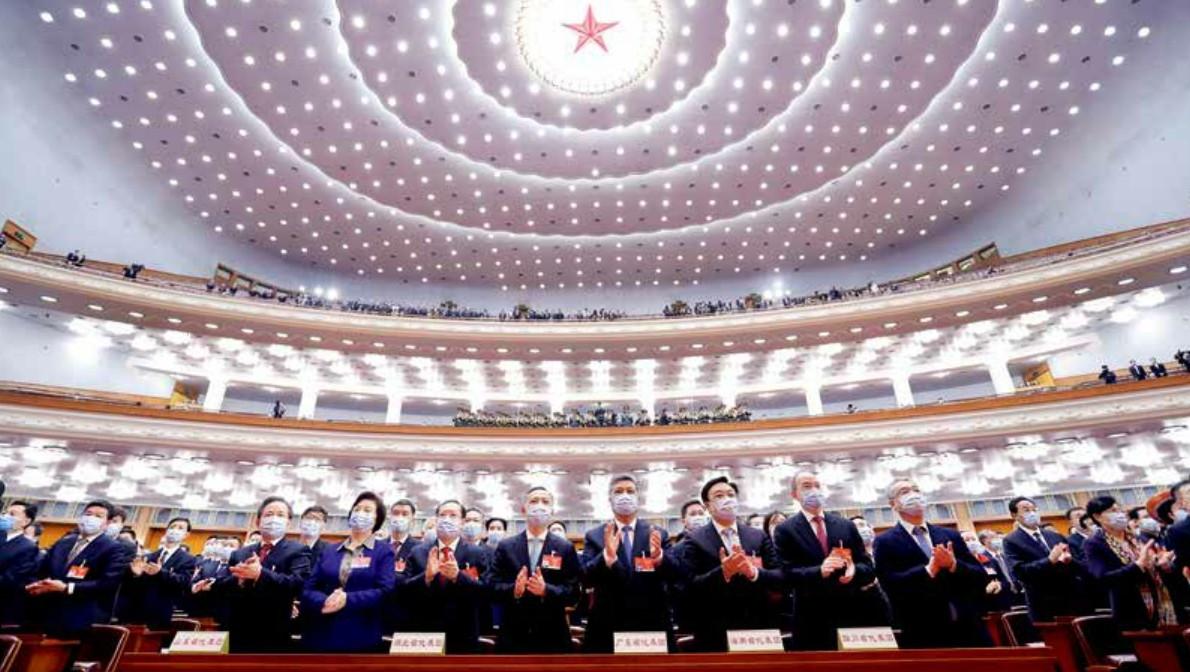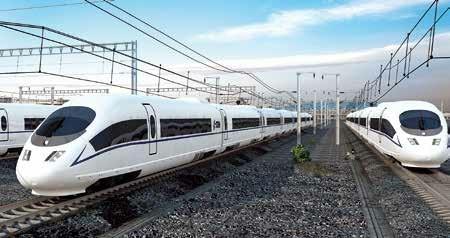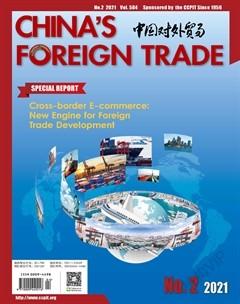Deepening Economic Reforms and Stimulating Market Vitality
By Lily Wang

In 2021, China will celebrate the 100th anniversary of the founding of the Communist Party of China, and will also comprehensively launch the 14th Five-Year plan to begin its new journey towards building a modern socialist country. This years“Two Sessions”(National Peoples Congress and Political Consultative Conference) conveyed a plethora of economic information against this backdrop.
Creating new demand through high-quality development
High-quality development should benefit more peoples lives. Chen Jing, NPC representative and Deputy Director of Shanghai NPC standing committee, explained that the 14th Five-Year Plan has raised the theme of high-quality development, which was a scientific judgement based on Chinas current development stage, environment and conditions. The key to realizing high-quality development is a high-quality GDP and financial revenue and expenditure. “It is important to allow high-quality development to benefit more peoples lives.” Chen Jing also emphasized that during the period spanning the 14th Five-Year Plan it is imperative to develop more inclusive finance systems and enhance financial risk control, to guarantee the safety and growth of peoples wealth, and to increase the size of the group of mediumincome people to allow them to enjoy a high-quality life.
High-quality supply should be used to create new demand: “The innovation and high-quality supply should both lead and create new demand.” The draft 14th Five-Year Plan accurately points out the relationship between innovation and consumption demand. The demand directs supply and supply creates demand. Innovation is the requirements for new development concepts and is also the driving force behind economic recycling. Chen Ailian, NPC representative and Chairman of Wanfeng Auto Holding Group, said, “from the supply side, it is imperative to focus on high-end market demand, and to use digital innovation and new-generational technology such as IOT, big data and AI to empower industries. It is also important to develop a batch of premium and high-end manufacturing industries to improve the industrial intelligence and commandeer the commanding heights of the industrial competition.”
Since last year, new energy vehicle sales have been booming. “At present, the auto consumption structure is becoming more and more diverse. Changan Auto has continued to improve its product and capacity structure and knocked out more than 20 types of uncompetitive products in the past three years,” said Zhu Huarong, NPC representative and Chairman of Changan Auto Company. He also explained that in line with the trend of automobile consumption upgrading, Changan Auto has been constructing a new brand structure, and will provide differentiated products targeting different markets to boost consumption. In order to realize high-quality supply, it is important to rely on innovation, as key technologies cannot be bought or borrowed from others. “Chinas self-owned auto brands must keep investing in R&D, and master key technologies. This will be the key to determining their competitiveness,” continued Zhu Huarong.
Promoting the upgrading of the manufacturing industry
The 14th Five-Year Plan (2021-2025) for National Economic and Social Development and the LongRange Objectives Through the Year 2035 points out that it is imperative to implement a manufacturing power strategy and promote the upgrading of the manufacturing industry. In the long run, China regards intelligent manufacturing as the main target for industrial upgrading. However, the issue of being“large but not strong” still exists.
“Intelligent manufacturing requires a large investment, a long period of return and high risks. Companies are normally unwilling to or incapable of getting involved,” said Lei Jun, NPC representative and Chairman & CEO of Xiaomi Group, before highlighting the idea that related departments need to provide a stable, well-planned and predictable policy environment. The policies themselves must play a more important role in the upgrading of equipment, self-innovation and construction of manufacturing systems, in order to inject momentum into the upgrading of companies.
When targeting insufficient selfinnovation and the high dependence on foreign technologies in intelligent manufacturing, Lei Jun said that it is important to build a coordinated R&D mechanism covering flagship companies, research institutions and first-grade universities, to develop high-quality sensors, precision speed reduction devices and servo motors, and to make breakthroughs in key technologies. It is also important to improve supporting policies and sup- port the R&D, upgrading and development of production lines.
Intelligent manufacturing develops quickly, covers a wide range of areas and has high demands on peoples comprehensive capabilities. In December, 2020, data from the Ministry of Education showed that in the areas of modern manufacturing, emerging strategic industries and modern service industries, more than 70% of newlyemployed people were graduates from vocational schools.
Chinas vocational education still lags far behind that in developed countries. The social recognition and reputation of vocational schools is still low, and enterprises are unwilling to invest in vocational training. Regarding this phenomenon, Yang Yuanqing, Chairman and CEO of Lenovo Group, suggests an enhancement of craftsmanship and the expansion of employment Channels. “We hope that policies willsupport improvements in the quality of vocational educational and play a more important role in the new industry model and patterns born in light of this wave of digital and intelligent operation. We need to support intelligent manufacturing to enter the high end of the global value chain,” continued Yang Yuanqing.
Innovation drives “dual circulation”
The construction and operation of the “dual circulation” new development pattern actually refers to the new circulation and allocation of various resources under the digital economy. The flow of industrial circulation is the core for building the “dual circulation”new development pattern. The key to realizing industrys “dual circulation”is technological innovation, especially digital innovation. The most important point is to promote the deep integration of industries with the new-generational digital technologies, including 5G, big data, AI, block chain and cloud computing. The innovation of digital technology will lead the way in terms of the industrys coordinated development and accurate matching between supply and demand. This will allow for the digitization of traditional industries and a transition towards the higher end of the global value chain.
Many representatives who attended the “Two Sessions” have expressed the idea that building the new development pattern requires breaking through the blocking points in the areas of production, distribution, transportation and consumption and smoothing out domestic circulation. Meanwhile, it is also important to implement high-level openingup to promote the integration between international and domestic markets and resources, propel high-quality economic development, and inject new momentum into the global economy. Dong Mingzhu, NPC representative and Chairman & CEO of Gree Group, said that in terms of increasing domestic demand and promoting internal circulation, China must make policies to promote dual circulation through technology and product upgrading. When the environment is good, enterprises will pursue opportunities to master key technologies. They will then engage in regional development, thus allowing sustainable technological innovation and business model innovation become the core competitiveness of enterprises.
Xu Rongmao, CPPCC standing member, Chairman of the China Federation of Overseas Chinese Entrepreneurs and chairman of Shimao Group, said that the Guangdong-Hong KongMacau Gulf Region has a very good location and a strong economy. It features both a cluster of innovative hubs and leads the world in terms of internationalization. As a window into traditional opening-up, it has good conditions and strong advantages for implementing the dual circulation development pattern. Xu suggests enhancing the infrastructural connectivity, building a wellconnected logistics system and creating a fast traffic network to improve the communication and logistics efficiency, while smart traffic should be developed by using IoT, cloud computing, AI, automatic control and other new-generational information technologies. The purpose of this is to enhance the smart city construction to allow the region to fully play to its strength in technological innovation.
Developing emerging industries of strategic importance
Building strong emerging indus-tries of strategic importance is a key task when building modern industrial systems and promoting high-quality development. It also has a large amount of significance when building a highquality regional economic landscape.
As a key emerging industry of the highest importance, the semiconductor industry is a key industry facing technology bottlenecks. Through years of development, Chinas new display industry value has surpassed RMB 400 billion, currently ranking first in the world. “However, continuous effort is still required to realize the transition from a large monitor-producing to a strong monitor-producing country. In the new-generation display industry, for example, in the field of OLEDs, foreign companies still have huge advantages, while domestic companies are still playing catch up,” explained Li Dongsheng, NPC representative and founder of TCL group. He also stressed that it is important to use technology innovation to promote the development of a new monitor industry, extend the industrial chain and formulate a comprehensive and efficient supply chain system.
“It is important to enhance toplevel design and encourage enterprises to increase their investments in R&D. It is also imperative to promote international communications in new-generation display technology, so as to match the best technologies in the world.” Li Dongsheng also said that domestic display panel producers including TCL are attempting to change the OLED production model from traditional evaporation to ink jet printing. The latter will reduce the loss of materials and has low requirements for the production environment. In the future, OLEDs will account for part of the high-end market of the large screen sector through their cost advantages.
In recent years, the new-generational IT technology, with semiconductors as the representative, has been attracting social attention. Thirdgeneration semiconductors including carborundum and gallium nitride are deemed to be the area in which the Chinese semiconductor industry could overtake other countries to snatch the leading position.
“Chinas third-generation semiconductor industry is still facing issues including being unable to control the core technology, repetitive constructions of low-level projects and a shortage of talent,” explained Wang Wenyin, CPPCC member and Chairman of Zhengwei International Group, before going on to express that the third-generation semiconductor industry covers a wide area. It is important to support several flagship companies in the industry and increase cooperation within the industrial chain.
At present, more than 90% of semiconductors are first-generation semiconductors. Third-generation semiconductors belongs to area of future investment. “It is imperative to properly allocate the resources in the semiconductor industry and develop key products. We need to combine the industrial, academic and research resources to develop more application scenarios, in order to shift the industry development away from being policydriven towards a market-driven model,”said Wang Wenyin.
New infrastructure investment redefining the future
Data shows that in 2020, China invested more than RMB 1 trillion in the new infrastructure sector, including industrial networks, big data centers, 5G and artificial intelligence. The proportion of investment for big data centers, 5G infrastructure, industrial networks and artificial intelligence was 52%, 27%, 11% and 10%.
As the main driving force behind new infrastructure, 5G has shown new progress throughout the first year of the period spanning the 14th Five-Year plan. By the end of 2020, China had opened up 718,0005G stations, with more than 200 million mobile phone users having access to 5G services. By March, 2021, there were 263 listed companies in the 5G sector, with a total market value of RMB 3.61 trillion. How can we integrate 5G technology with the social economy, and make 5G more accessible for more Chinese people. Yang Jianyu, NPC representative and General Manager of Henan Mobile, highlighted the fact that the industrial upgrade has urgent needs in terms of IT technology. The empowering of traditional industries to make a network-based, digital and intelligent transition and the unleashing of the power of digital technology for economic development require the building of a 5G-capable system that features “special network+talent+ecology+platform+termin al”, in order to promote the integration of 5G technology in all sectors and benefit people in the social community.
Whether to introduce charging piles in residential areas has become a heated topic of discussionat this years Two Sessions. The charging pile industry has stable demand and is growing quite rapidly. It is known that at present, on the A-share market, there are 121 listed companies engaging in charging pile-related business, with a total market value of RMB 1.797399 trillion. There are 93 companies with a market value lower than RMB 10 billion, accounting for 76.86% of the total. Only three companies(BYD, Nari Technology Development and Sungrow) have a market value surpassing RMB 100 billion. Zhou Fugeng, NPC representative and senior engineer of JAC Group, suggests that the national government shouldset medium- and long-term objectives for charging pile constructions through the year 2035, so as to further clarify the direction, standards and implementation requirements for building charging facility networks in residential areas, expressways and public spaces in both urban and rural areas. It should also provide clear directions for the local government and the market. Xiao Lichun, NPC representative and chairman of State Grid Hubei Electric Power Co., Ltd., suggested the unitary con-struction and management of charging piles in residential areas, and allowing the real estate management departments, subdistrict offices and neighborhood committeesto take responsibility for them. This would encourage social operators to conduct unitary planning, construction and operation of the charging piles in residential areas, and clarify electric price standards. For newly-built residential areas, the proportion of parking spots equipped with charging piles would then be fully taken into consideration in advance.

Developing new energy is the current trend. This years government work report points out that we must implement the work towards a carbon peak and then carbon neutrality and formulate an action plan for ensuring that the carbon peak occurs before 2030. It is also necessary to optimize the industrial and energy structure, promote the clean and efficient use of coal resources and the development of new energy sources. Nan Cunhui, CPPCC standing member and Chairman of Chint Group, said that PV will play an important role in energy upgrading and the realization of the carbon neutrality goal.
AI has deeply changedour way of life and learning, and has promoted structural upgrades in employment. Robin Li, CPPCC member and Chairman & CEO of Baidu, said that it is important to increase the number of AI majors in universities and accelerate the building of an AI-related vocational training system, in order to help people master new skills and land a good job.
The “digital transition” to empower businesses has been acknowledged by various industrial sectors, and traditional industries are now actively promoting the digital transition. In terms of this digital transition, Guo Wei, Chairman & CEO Of Digital China, said that the fifth session of the 19th CPC Central Committee has placed emphasis on the building of a powerful country in the spheres of manufacturing, quality, networks and digitization. The basis of building a powerful country in terms of manufacturing and quality is the restructuring of the economy through the digital technology and achieving industrial upgrades. Therefore, in the future, Digital China will continue to make innovations based on cloud computing and big data technologies, so as to promote the upgrading of industrial bases and the modernization of the industrial chain and to improve the quality and benefits of the economy and core competitiveness. With regard to how to speed up the digital transition, Zhou Yunjie, NPC representative and President of Haier Group, suggested building a national industrial network platform open source union to encourage developers to contribute open source codes and application systems, and to empower businesses to make the digital transition.
Zhang Jindong, NPC representative and Chairman of Suning Group, said, “digitization represents the big trend, while new infrastructure is the key to building dual circulation. During the period of the 14th Five-Year Plan, industries will encounter new opportunities. At the moment, the digital transition of the national economy has become the main trend and new infra- structure is speeding up this transition. In addition, new infrastructure is able to promote the construction of scenario networks, and scenario networks and the intelligent supply chain will be the heated area of investment for retail companies. We hope that with the support of new infrastructure, Suning will be able to accelerate the digital transition of the storage and logistics supply chain, and work with other operators to promote the application and innovative development of 5G in the retail sector.”
When faced with the huge development opportunities brought about by“new infrastructure”, more and more sectors and companies are deeming “data”to be the core of their resources, assets and wealth, and are making their own digital transition strategies to capitalize on the commanding heights of the digital economy. The integration of big data, IoT and artificial intelligence will help users find the commercial value contained in data, and to achieve rapid innovation, intelligent business development, and leap-frog development in the digital transition for companies.
“As digital technology continues to be integrated into the real economy, industrial digitization has huge development potential and has become the main force driving the digital economy,” said Xu Xiaolan, CPPCC member and Director of the China Academy of Industrial Internet, while suggesting that it is important to follow the path of digital industrialization and industrial digitization to promote the deep integration between the digital technology and the real economy.
Infrastructure is the key to developing the digital economy. Xu Xiaolan also suggests that it is important to shift the direction of investment from traditional equipment and technology towards the improvement of digital technology of industries, in order to promote the application of the industrial internet in stages and in different sectors. It is also imperative to promote the systemic construction of big data centers for the national industrial internet around the country, to formulate the industrial data resource management system, to enhance the accumulation capability of industrial data, to play to the strength of data services and to consolidate the basis for industrial digitization.
- China’s foreign Trade的其它文章
- Chinese Elements Highlight the Charms of Fashion
- Post-epidemic Demand for Talent Illustrates New Trend
- The Number of Overseas Students Returning to China Has Doubled
- Insight into the Trends in Chinese Enterprises Affected by the Pandemic
- China and Thailand Discuss Innovative Investment Online
- Feet Firmly on the Gas Pedal in GBA

